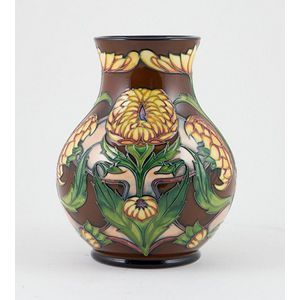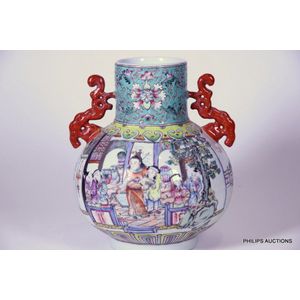Mid-20th Century Famille Rose Vase with Figural Scenes
You must be a subscriber, and be logged in to view price and dealer details.
Subscribe Now to view actual auction price for this item
When you subscribe, you have the option of setting the currency in which to display prices to $Au, $US, $NZ or Stg.
- Oviform /ovoid - The outline loosely resembling the shape of an egg.
- Lappet Decoration - In the context of furniture, ceramics, and oriental wares, the word "lappet" refers to a decorative motif that consists of a repeated pattern of stylized or abstracted "lappets."
A lappet in this context is a decorative element that resembles a small, hanging flap of cloth or fabric, but rather are stylized patterns that resemble the shapes and folds of lappets. They can be found on a wide range of objects, including furniture, vases, bowls, and plates.
Lappet decoration can take many different forms, but typically consists of a series of semi-circular or pointed shapes that are repeated in a continuous pattern. The shapes may be simple or highly ornate and may be arranged in a regular or irregular pattern. The design may also include other decorative elements, such as floral or foliate motifs.
Lappet decoration is often associated with Asian design traditions, and can be found on a wide range of objects from these regions, including Chinese porcelain, where lappet decoration is often used as a symbol of abundance and prosperity, and is believed to have protective and auspicious qualities. - Circa - A Latin term meaning 'about', often used in the antique trade to give an approximate date for the piece, usually considered to be five years on either side of the circa year. Thus, circa 1900 means the piece was made about 1900, probably between 1895 and 1905. The expression is sometimes abbreviated to c.1900.
This item has been included into following indexes:
- Chinese ceramics, dynasty mark or period - vases, Qianlong mark (1736-1795) 368
- Chinese ceramics, famille decoration - famille rose, vases 601
-
Chinese ceramics, item type
- figurines 1,568
- vases, other 2,484
Visually similar items

A Chinese famille-rose twin-handled vase, Jiaqing six-character iron-red seal mark 28.5 cm high

Kangxi period style blue & white lidded ginger jar painted with Geishas in traditional dress against a landscape, with double ring marks, height 33 cm

Modern Moorcroft baluster vase Dahlia pattern, signed Philip Gibson limited edition 151/250 2003, 24 cm height, boxed

A Chinese porcelain vase, elephant head handles, decorated with flowering plant the reverse with calligraphy. Height 19 cm
